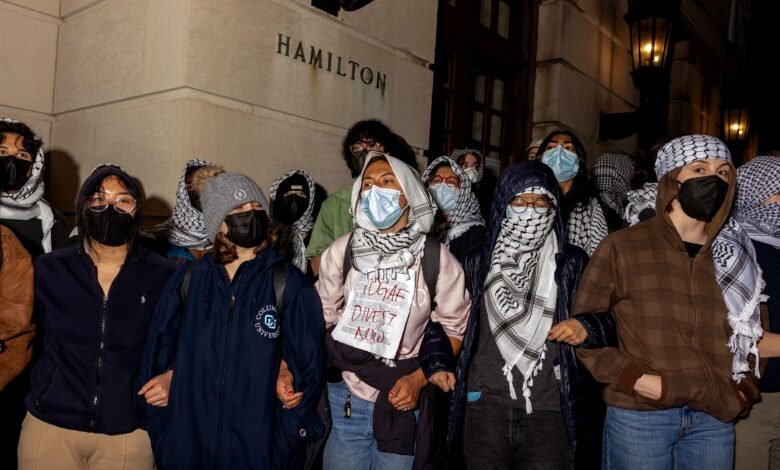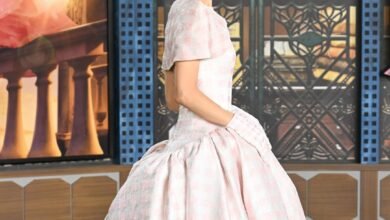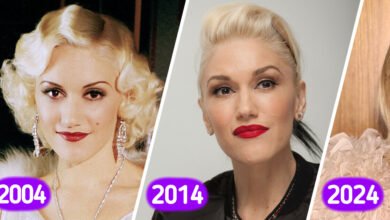“Everything Felt Really Dystopian”: Columbia Student Journalists on the Front Lines of Gaza Protests

When Gillian Goodman got the call at 11 p.m. on Monday evening, she expected it to be one more false alarm. The Columbia Journalism School graduate student had been in touch with various activist groups to see when they’d mobilize, but “there have been so many ‘boy who cried wolf’ moments—you think some big action is going to happen, you throw your pajamas off and rush to campus at midnight, and then nothing happens,” she told me. “But I think it’s just always about showing up.” Show up she did, to find pro-Palestinian protesters, who had spent nearly two weeks in a tent encampment on the school’s lawns in protest of Israel’s offensive in Gaza and Columbia’s investment ties to Israel, escalating their demonstration by forcing their way into Hamilton Hall. “Watching the hammer come through the window and watching them barricade the doors was one of the craziest things that I’ve seen in a long time,” said Goodman.
A day later, hundreds of NYPD officers in riot gear—called in at Columbia president Minouche Shafik’s request—stormed onto campus, arresting more than 100 people. “Police were really, really adamant and effective at clearing out press and medics and legal observers,” Goodman said. “There was this feeling that we had seen this from the beginning, and we were so desperate to see it until the end.”
A demonstrator breaks the windows of the front door of the building in order to secure a chain around it to prevent authorities from entering as demonstrators from the pro-Palestine encampment barricade themselves inside Hamilton Hall on April 30, 2024 in New York City.By Alex Kent/Getty Images.
Columbia Journalism School students are about to graduate, but already, they have put into practice what they’ve spent the past year learning. For weeks and, for some, months, the graduate students have chronicled the protests taking place on their campus, through photojournalism, written accounts, and audio—reporting that has informed outlets around the world. They’ve also set up an account to fact-check misinformation about what’s going on in their backyard. (The Columbia Daily Spectator, which is led by undergraduates, and radio station WKCR, have also provided comprehensive and widely praised coverage.)
Vanity Fair caught up with J-School students who have a unique access to cover this story, especially this week, when, amid the escalating protests, Columbia went on lockdown, suspending outside media access and restricting the Morningside campus to essential personnel and students living in on-campus residence halls. On Wednesday morning, hours after the NYPD took students into custody and dismantled the encampment, Indy Scholtens, a graduate student from the Netherlands, was one of the only people in front of Hamilton Hall, which was also famously occupied in 1968 by student activists opposing racial injustice and the Vietnam War.
“I was just taking pictures of the broken windows, public security officers standing in front of [Hamilton Hall], and at one point I see four people going in,” Scholtens told me. One, she realized, was Shafik, who before then had not appeared at the encampment or building. “I captured that moment,” she said. Getty has since purchased a few of her photos.
Columbia University President Minouche Shafik visits Hamilton Hall on the campus of Columbia University on May 1, 2024 in New York City.
By Indy Scholtens/Getty Images.
The encampment started on the day that Ty Lawson’s class was, coincidentally, discussing breaking news. Lawson, a visiting professor, looked out the window to see protesters starting to set up shop. “So I was like, you have real-life breaking news out there; get out there and cover it,” Lawson told me. Other professors decided to scrap whatever was on their syllabi and have their students cover the same. “It was one of those organic moments where we’re all still journalists, even though we’re educators now,” said Lawson, a former Good Morning America producer. “Several other faculty members were like, we’ve got to all get on board with this and support the students the best way we can. This is history…this is the news, this is the story. We are the source.”
Since the beginning of the encampment, Nina Berman, a professor and documentary photographer and filmmaker, had been doing nightly outings with students, training them in the field while also keeping them safe, according to Azmat Khan, another professor. Khan, a Pulitzer Prize–winning investigative reporter, has also been preparing students to cover the protests on campus and outside of it, training that has ramped up in recent weeks. “There’s concerns, because they are students and also journalists, and yet not necessarily afforded all of the same protections in some cases. So how do they really distinguish themselves from protesters?” Khan told me. She said that she and Stuart Karle, a lawyer who teaches media law, held a combined safety and legal support seminar in the lead-up to this moment, requiring them for any student who would be on campus once access became restricted.
It felt, students in the graduate school said, like the police could come at any point on Tuesday. “It was very quiet during the day. Everything felt really dystopian,” said student Angelica Ang. Many had slept on campus to make sure they were there if something happened—including Khan, who spent several nights sleeping in her office—balling up a jacket as a pillow in classrooms, or, in the case of Brendan Rose, on the couch in the World Room, an auditorium on campus that also happens to be where the Pulitzers are announced. Rose woke up early on Tuesday morning to an evacuation order: Faculty and students were told they could no longer use Pulitzer Hall, where the journalism school is housed. According to faculty, Jelani Cobb, the dean of the journalism school, pushed against this, negotiating with the administration so that students and faculty could stay in Pulitzer Hall if they remained confined to one room—before, people had been dispersed throughout the building—called the Brown Institute. (Cobb did not respond to an interview request.)
Demonstrators from the pro-Palestine encampment on Columbia’s Campus barricade themselves inside Hamilton Hall on Tuesday, April 30, 2024 in New York City.by Alex Kent/Getty Images.
The ground-floor suite, outfitted with long tables and chairs, became a kind of war bunker, with an air mattress in one corner, a pile of blankets in the window, pizza everywhere, and various stockpiled supplies (floss, sunscreen, deodorant). “Something insane about all of this is it’s happening directly in front of us,” said Rose, noting that the Brown Institute looks out directly onto where the encampment was and across to Hamilton Hall. “There’d be moments where people would periodically step out and look at what was going on with this real nervous energy,” he added. “Student journalism is such an interesting foot in two worlds because it blurs the line between participant and observer,” said Goodman.




